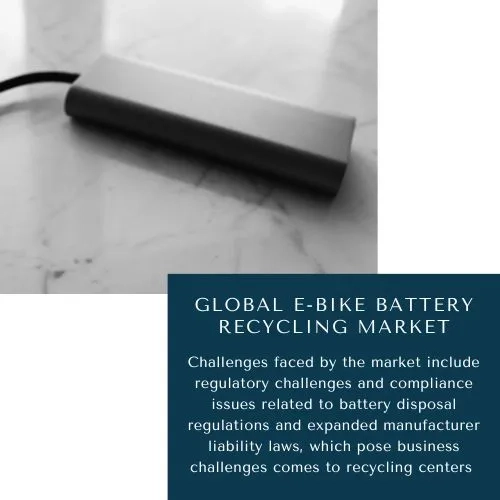
- Get in Touch with Us

Last Updated: Apr 25, 2025 | Study Period: 2024-2030
The global e-bike battery recharge market is witnessing tremendous growth owing to the rapid adoption of electric bicycles across the globe. As e-bikes continue to grow in popularity, the need for efficient solutions to recharge their batteries becomes paramount. The market has been driven by increased environmental awareness and legislation aimed at reducing electronic waste and enforcing sustainable practices in transportation

Technological advances in battery recycling are changing the market. Innovations in extraction and packaging technology enable the precise extraction of valuable components from end-of-life e-bike batteries. These developments not only make recycling more efficient, but also contribute to conservation and a circular economy, significantly expanding the market
However, the e-bike battery recycling market also requires compliance with stringent safety and environmental regulations for proper handling and disposal of battery components a battery components including complexity and the presence of hazardous materials, leading to operational difficulties and costs in recycling In addition to limited recycling resources and know-how consumer access creates barriers at the edge of market development, thus requiring stakeholders to make concerted efforts to overcome these barriers
E-bike battery recycling represents an integral part of sustainable transportation as electric bikes gain more popularity as a cleaner and more efficient way to transport These batteries, which often no it is lithium-ion, plays an important role in powering e-bikes but poses environmental challenges once they reach their end of life The number of e-bikes increases and so the need for environmentally efficient recycling solutions are found will be essential to reduce electronic waste and reduce the ecological footprint of electric propulsion
The process of e-bike battery recycling involves the collection, separation and recovery of valuable components from spent batteries. This includes steps such as sorting, spinning and finishing to remove materials such as lithium, cobalt and nickel for reuse in new batteries or other products is not like if recycling is done properly , not only conserves limited resources but reduces the environmental impact of battery mining and battery manufacturing processes
E-bike battery recycling programs align with broader sustainability goals, emphasizing the importance of circular economic principles in the transport industry. By diverting end-of-life batteries from landfill and incineration, recycling efforts contribute to conservation, energy efficiency and pollution reduction, and provides a sustainable and environmentally friendly option on e-mobility

The Global E-Bike Battery Recycling Market was valued at $XX Billion in 2023 and is projected to reach $XX Billion by 2030, reflecting a compound annual growth rate (CAGR) of XX% from 2024 to 2030.
Advanced Battery Separation Techniques
Technological advances in e-bike battery recycling have focused on improving the separation process. Innovations in separation and packaging technology are enabling precise separation of battery components such as lithium-ion cells, electrolytes and fillers, resulting in valuable recovery the rate of increase has been weakened
Chemical recycling methods
Emerging trends in the global e-bike battery recycling market include chemical recycling methods to recover materials from end-of-life batteries Demand processes such as hydrometallurgy processes and pyrometallurgy to remove metals such as lithium, cobalt and nickel from battery component s are available
Closed-Loop Recycling Systems
Technological advances are also driving the use of closed recycling systems for e-bike batteries. These initiatives aim to connect recycling facilities with battery manufacturing facilities to create a circular economy. Closed systems that incorporate recycled materials into new battery production reduce reliance on virgin materials and reduce environmental impact
ENYRING
Yamaha has introduced ENYRING, a collaborative project focused on simplifying battery recharging, reducing costs and promoting sustainability in urban transport, especially for electric bikes initially in Berlin, Germany and soon expanded to the Netherlands. To streamline is by repurposing old batteries to be used as storage batteries through a process of recycling and reusing ENYRING seeks to minimize waste and maximize resource efficiency Usually e-bike batteries are considered at the end of life period when due to the power draw when riding hard with 70-80% of their original capacity reaching the part, reducing the range but this system expects that this battery has a second life as a stable battery in an energy storage system, contributing to a sustainable e-bike battery life
Torqueâs Kratos R
Lohum and Torque Motors have collaborated to recycle the lithium-ion batteries used in Torqueâs Kratos R electric motorcycle. This partnership, the first Torque Battery Extended Manufacturer Responsibility (EPR) collaboration in India, confirms a collective commitment towards sustainability and low-carbon EV battery material supply chain battery waste regulation and manufacturer responsibility certification; expanded Compliance partnerships ensure compliance and contribute to long-term sustainability and positive environmental impact. Torque Kratos R electric motor, with 9 kW 'axial flux' motor and 4.0 kWh Li-ion battery pack, at 180 km Supply of recycled raw materials for battery packs by recycling batteries at the end of life will not increase, and decrease mining demand.
Safe Charge line
CellBlock Fire Containment Systems, known for its innovations in battery safety, has launched two new products with its Safe Charge line of products designed for lithium-ion batteries used in e-bikes, scooters, and small cars among others .These new features complement the existing Safe Charge Rack, which provides a complete solution for safely charging micro mobility batteries, which are FDNY-certified for charging up to 40 batteries. The primary technical officer responsible for E-Bike-fire-processing is the benefit of effective fire-fighting products provided outside of the FDNY. Setting new safety standards for ick conservation, ensuring timely fire suppression and evacuation for building occupants
| Sr.N | Topic |
| 1 | Market Segmentation |
| 2 | Scope of the report |
| 3 | Research Methodology |
| 4 | Executive Summary |
| 5 | Average B2B by price |
| 6 | Introduction |
| 7 | Insights from Industry stakeholders |
| 8 | Key Drivers for global e-bike battery recycling market |
| 9 | Disruptive Innovation in the Industry |
| 10 | Overview of global e-bike battery recycling market |
| 11 | Major impact on Technological advancements |
| 12 | Consumer trends in the industry |
| 13 | Recent technological trends in global e-bike battery recycling market |
| 14 | SWOT Analysis of Key Market Players |
| 15 | New product development in the past 12 months |
| 16 | Market Size, Dynamics, and Forecast by Geography , 2024-2030 |
| 17 | Market Size, Dynamics, and Forecast by Recycling Process, 2024-2030 |
| 18 | Market Size, Dynamics, and Forecast by Battery Type , 2024-2030 |
| 19 | Market Size, Dynamics, and Forecast by End User, 2024-2030 |
| 20 | Competitive landscape |
| 21 | Gross margin and average profitability of suppliers |
| 22 | Merger and Acquisition in the past 12 months |
| 23 | Growth strategy of leading players |
| 24 | Market share of vendors, 2023 |
| 25 | Market Company Profiles |
| 26 | Unmet needs and opportunities for new suppliers |
| 27 | Conclusion |